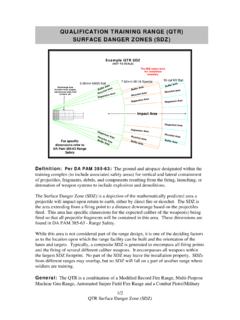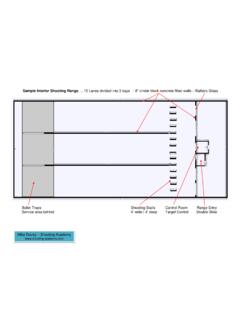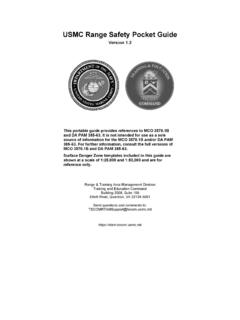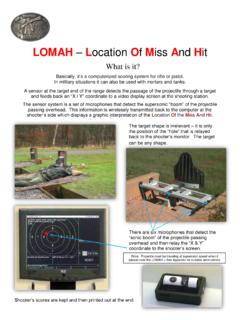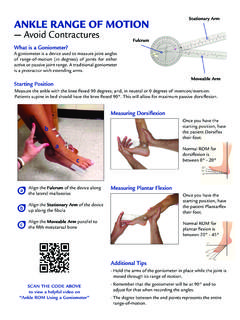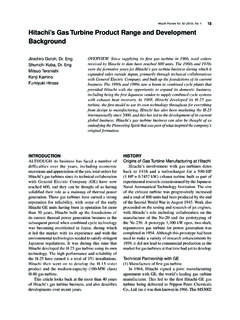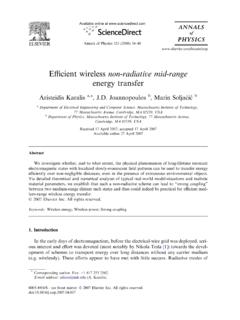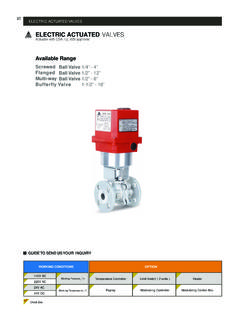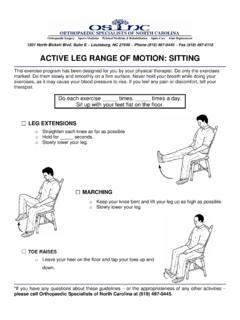Transcription of DA PAM 385-63 RANGE SAFETY - Shooting Academy
1 Department of the ArmyPamphlet 385 63 SafetyRange SafetyHeadquartersDepartment of the ArmyWashington, DC10 April 2003 UNCLASSIFIEDSUMMARY of CHANGEDA PAM 385 63 RANGE SafetyThis new pamphlet implements the requirements of AR 385-63 and other covers the minimum RANGE SAFETY standards and procedures for the design,management, and execution of RANGE SAFETY programs. This pamphlet--o Prescribes installation and unit--level RANGE SAFETY program guidelines(para 1-6).o Prescribes criteria for RANGE SAFETY certification (para 1-7).o Provides standards and procedures for RANGE access and control (chap 2).o Provides SAFETY standards for indoor ranges (para 2-6).o Provides guidance on the positioning and issuing of ammunition and explosiveson ranges and other related ammunition topics (chap 3).o Provides bat wing surface danger zone criteria for various weapons and weaponsystems (app B).
2 O Provides guidance on surface danger zone design (app C).HeadquartersDepartment of the ArmyWashington, DC10 April 2003 SafetyRange SafetyDepartment of the ArmyPamphlet 385 63 History. This is a new Department of theArmy The Army and Marine Corpswill use this pamphlet in conjunction withA r m y R e g u l a t i o n 3 8 5 6 3 / M a r i n e C o r p sOrder , to establish and maintaina comprehensive RANGE SAFETY The standards and proce-dures in this pamphlet apply to all person-nel and RANGE operations and activities onArmy or Marine Corps controlled prop-erty or within Army or Marine Corps ju-risdiction. The provisions of this pamphletapply in peacetime and contingency oper-ations and are advisory for actual combatoperations. Except for airspace and watert r a f f i c s a f e t y r e q u i r e m e n t s , t h e s e p r o v i -sions do not apply to development, proofand function test ranges , or o w e v e r , m a j o r A r m y c o m m a n d s a n dM a r i n e C o r p s i n s t a l l a t i o n s h a v i n g s u c hr a n g e s a n d l a b o r a t o r i e s a r e r e q u i r e d t odevelop and apply alternate standards thatare appropriate to the mission and thate n s u r e t h e p r e s e r v a t i o n o f l i f e a n and exception Chief of Staff, Army, is the Armyproponent.
3 The proponent has the author-ity to approve exceptions to this pamphletconsistent with controlling law and regu-lation. The proponent has delegated ap-proval authority to the Director of improvements. Army us-ers are invited to send comments and sug-gested improvements on DA Form 2028( R e c o m m e n d e d C h a n g e s t o P u b l i c a t i o n sand Blank Forms) directly to the Directorof Army SAFETY , Office of the Chief ofS t a f f , D A C S S F , 2 0 0 A r m y P e n t a g o n ,W a s h i n g t o n , D C 2 0 3 1 0 0 2 0 0 . M a r i n eC o r p s u s e r s w i l l s u b m i t c o m m e n t s a n dsuggestions for improvements to the Com-manding General, Marine Corps CombatD e v e l o p m e n t C o m m a n d ( C 4 6 R ) , 3 3 0 0 Russell Road, Quantico, VA 22134 This publication is availa-b l e t o A r m y u s e r s i n e l e c t r o n i c m e d i aonly and is intended for command levelsA, B, C, D, and E for the Active Army,the Army National Guard of the UnitedStates, and the Army Reserve.
4 Publi-cation and distribution to authorized usersfor Marine Corps commands are indicatedi n t h e T a b l e o f A l l o w a n c e s f o (Listed by paragraph and page number)Chapter 1 Introduction, page 1 Purpose 1 1, page 1 References 1 2, page 1 Explanation of abbreviations and terms 1 3, page 1 Applicability 1 4, page 1 Deviations 1 5, page 1 Installation and unit level RANGE SAFETY Program guidelines 1 6, page 2 Guidelines for RANGE SAFETY certification programs 1 7, page 7 Chapter 2 ranges , page 8 Restricting access to impact areas 2 1, page 8 Posting warning signs and markers 2 2, page 8 Controlling other RANGE usage 2 3, page 9DA PAM 385 63 10 April 2003iUNCLASSIFIEDDISTRIBUTION STATEMENT A: Approved for public release.
5 Distribution is 30503504600 Contents ContinuedCoordinating use of special use airspace 2 4, page 9 Coordinating use of navigable waterways 2 5, page 11 SAFETY requirements for indoor firing ranges 2 6, page 11 Chapter 3 Ammunition, page 13 Smoking 3 1, page 13 Positioning and issuing ammunition and explosives 3 2, page 13 Qualification and restriction of ammunition and explosives 3 3, page 14 Suspension of ammunition and explosives involved in malfunctions 3 4, page 15 UXO and misfire procedures and reporting 3 5, page 16 Disposition of ammunition and explosives involved in malfunctions and accidents 3 6, page 16 Destruction of UXO 3 7, page 16 Policing the training complex 3 8, page 16 Army requirements for areas known to contain ICMs and submunitions 3 9, page 17 Chapter 4 Firing, page 20 Special firing instructions 4 1, page 20 Warning signs and signals 4 2, page 20 Firing conditions for ADA guided missiles and rockets 4 3, page 20 Firing conditions for antitank guided missiles and rockets 4 4, page 21 SAFETY requirements for firing aerial pyrotechnics (Marine Corps only)
6 4 5, page 21 Chapter 5 Targets, page 21 General requirements for moving targets 5 1, page 21 Airborne and ground targets 5 2, page 21 Waterborne targets 5 3, page 21 Radio controlled targets 5 4, page 22 Aerial targets 5 5, page 22 Ballistic aerial targets 5 6, page 22 Chapter 6 Small Arms, page 24 Firing conditions 6 1, page 24 Overhead fire 6 2, page 24 Flanking fire 6 3, page 25 Shotgun ranges 6 4, page 25 Surface danger zone 6 5, page 27 Blank ammunition 6 6, page 27 Recreational ranges 6 7, page 27 Chapter 7 Grenades and Grenade Launchers, page 27 Hand grenades 7 1, page 27 Grenade launchers and grenade machineguns 7 2, page 29 Chapter 8 Antitank Rockets, page 34 Firing conditions 8 1, page 34 Surface danger zone 8 2, page 34 Chapter 9 Recoilless Weapons, page 42 Firing conditions 9 1, page 42iiDA PAM 385 63 10 April 2003 Contents ContinuedSurface danger zone 9 2, page 42 Chapter 10 Mortars, page 47 Firing conditions 10 1, page 47 Surface danger zones 10 2, page 47 Chapter 11 Field Artillery, page 49 Procedures and precautions 11 1, page 49 SAFETY certification program 11 2, page 49 Field artillery cannons 11 3, page 49 Field artillery cannon SDZs 11 4, page 50 Antipersonnel ammunition (beehive) 11 5, page 56 Cannon launched guided projectile (Copperhead)
7 11 6, page 58 Flight corridors 11 7, page 62 Improved conventional munitions 11 8, page 64 Field artillery trainer 11 9, page 65 Multiple launch rocket system (MLRS) 11 10, page 69 MLRS reduced RANGE practice rocket 11 11, page 72 Chapter 12 Tank/Fighting Vehicle Gunnery, page 76 Tank cannon firing conditions 12 1, page 76 Surface danger zone 12 2, page 76 Fighting vehicles 12 3, page 84 Subcaliber tank gunnery devices 12 4, page 89 Grenade launchers 12 5, page 89 Weapons effect signature simulator 12 6, page 93 Hazardous impulse noise exposure 12 7, page 93 Firing vehicle status designations 12 8, page 96 Close support of ground personnel in live-fire exercises 12 9, page 97 Chapter 13 Aviation Gunnery, page 97 Firing operations, general requirements 13 1, page 97 Firing conditions, general procedures 13 2, page 97 Gunnery operations 13 3.
8 Page 98 Surface danger zones 13 4, page 98 HELLFIRE antitank guided missile (semiactive laser) 13 5, page 102 Stinger guided missile 13 6, page 108 Chapter 14 Air Defense Artillery Weapon Systems, page 108 General 14 1, page 108 Firing conditions, general requirements 14 2, page 108 Air defense artillery target missiles 14 3, page 109 Redeye guided missile (Army) 14 4, page 109 Stinger guided missile 14 5, page 110 Chaparral guided missile 14 6, page 114 Patriot guided missile 14 7, page 115 Improved Hawk guided missile (Army) 14 8, page 117 Trajectory corridor 14 9, page 121iiiDA PAM 385 63 10 April 2003 Contents ContinuedChapter 15 Antitank Guided Missiles, page 121 TOW missiles 15 1, page 121 DRAGON and DRAGON generation II guided missiles 15 2, page 134 JAVELIN Guided Missile 15 3, page 139 Chapter 16 Chemical Agents and Smokes, page 142 Chemical agents 16 1, page 142 Riot control agents 16 2, page 142 Smoke 16 3, page 143 Smoke pots 16 4, page 143 Oil smoke candles 16 5, page 144 Chloroacetophenone 16 6, page 144 Chapter 17 Mines, Firing Devices, Trip Flares, Simulators, and Explosive Charges, page 144 General 17 1, page 144 Firing devices 17 2, page 147 Shaped charges 17 3.
9 Page 149 Bangalore torpedoes 17 4, page 149 Mine-clearing snakes 17 5, page 150 Blast-driven earth rod 17 6, page 150 Mine-clearing line charge 17 7, page 150 Cratering charges 17 8, page 153 Mines 17 9, page 154 Firing devices 17 10, page 157 Trip flares, M48, and M49 17 11, page 157 Simulators 17 12, page 158 Training conducted in explosive entry techniques (USMC) 17 13, page 158 Chapter 18 Laser RANGE SAFETY , page 159 Fundamentals 18 1, page 159 RANGE usage 18 2, page 160 Force on Force tactical exercises 18 3, page 160 Chapter 19 Live-Fire Exercises, page 161 SAFETY during live-fire exercises 19 1, page 161 Information for commanders 19 2, page 161 Exercise planning 19 3, page 161 Firing precautions 19 4, page 162 Fire control 19 5, page 163 Maneuver in temporary impact areas 19 6, page 163 Air support 19 7, page , page Wing Surface Danger Zones, page Danger Zone Design, page 180ivDA PAM 385 63 10 April 2003 Contents ContinuedTable ListTable 1 1: OIC/RSO appointment requirements, page 4 Table 2 1.
10 Breathing zone exposure limits for intermittent atmospheric lead exposures, page 11 Table 5 1: Ballistic aerial target system surface danger zone, page 22 Table 6 1: Minimum thickness of material for positive protection against caliber ammunition listed, page 24 Table 7 1: Surface danger zone dimensions for 40-mm machinegun, MK19, MOD3, page 32 Table 8 1: Antitank rocket launcher SDZ criteria, in meters, page 34 Table 8 2: Maximum ranges at various quadrant elevations (QE) for the 35-mm M73 practice rocket, page 35 Table 8 3: RAAWS/MAAWS SDZ criteria, in meters, page 37 Table 8 4: AT 4 surface danger zone criteria, in meters, page 40 Table 9 1: Recoilless rifles surface danger zone criteria (in meters), page 43 Table 9 2: Distances required for firing antipersonnel cartridges at quadrant elevations of 15 or less, page 43 Table 10 1: Mortar surface danger zone criteria, in meters1, 2, 3, page 47 Table 10 2: Basic impact area dimensions, page 49 Table 11 1: Basic impact area dimensions, page 51 Table 11 2: Field artillery cannon SDZ criteria, in meters, page 55 Table 11 3: Heights of burst above occupied armor vehicles, in meters, page 56 Table 11 4: Beehive SDZ criteria, in meters, page 57 Table 11 5: Maximum RANGE data sources for I
